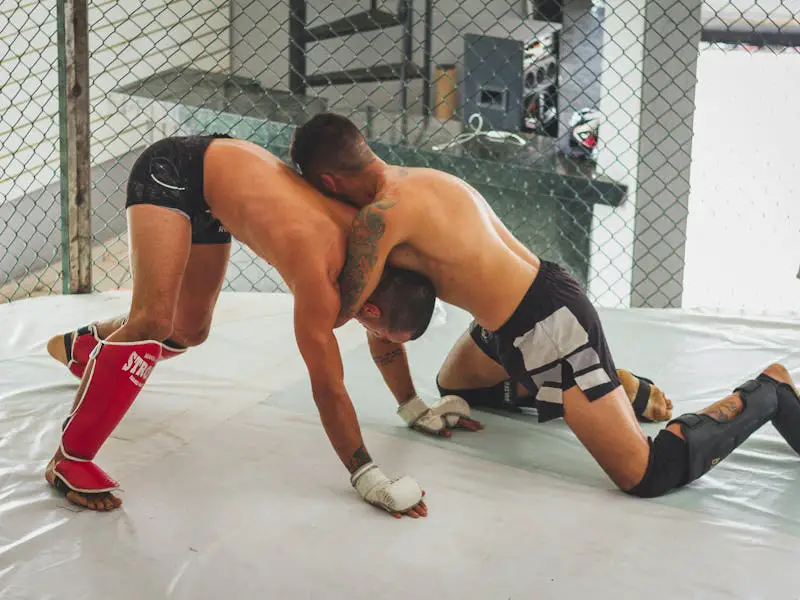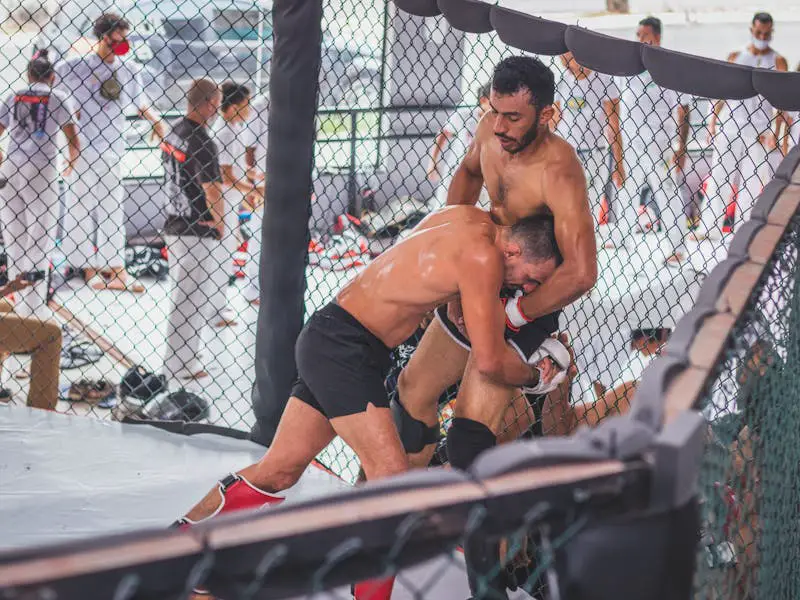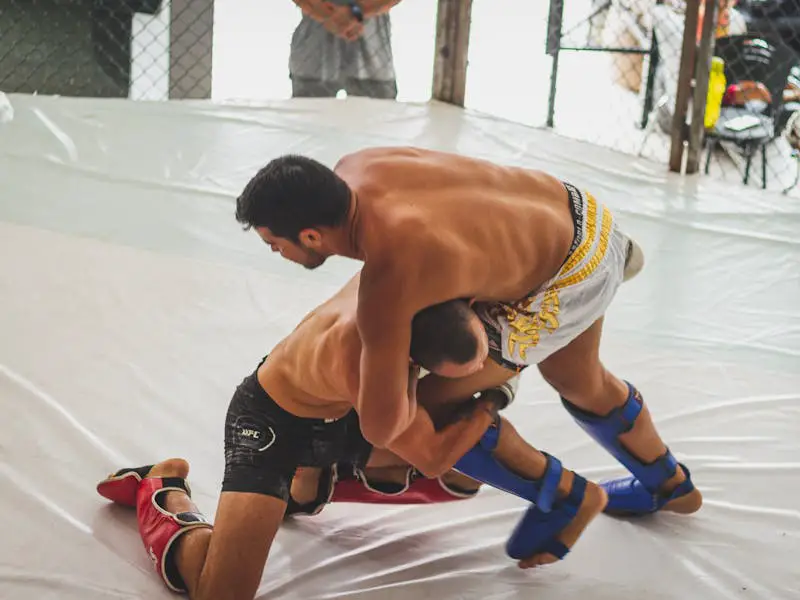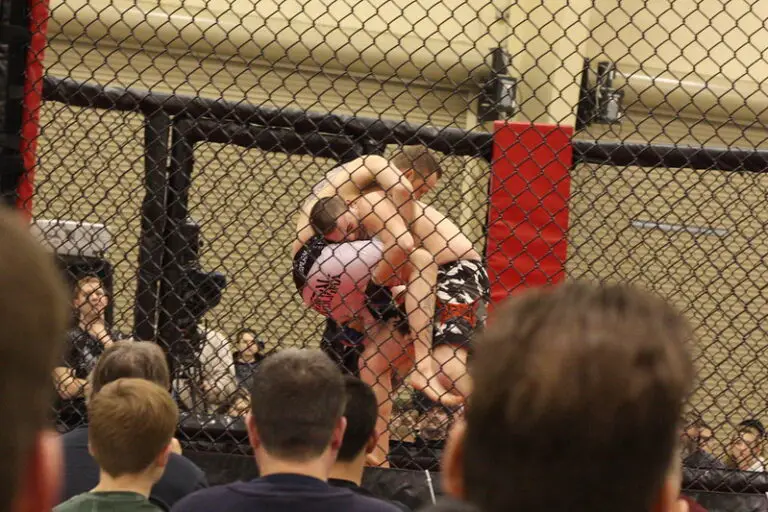Wrestling is the single most important skill in modern MMA and this martial art has produced the most UFC champions in history. Thus, knowing how to defend a takedown is essential if you want to succeed in the sport.
In modern times, no one can expect to succeed in MMA, not even on the regional scene, without having the ability to wrestle and stop a takedown. No matter how good their striking might me, they must know how to defend a takedown in MMA.
This article brings you a comprehensive guide on how to do it. We are going to take a close look at the most common takedown techniques, and techniques and counterattacks to defend against it.
Types of Takedowns in MMA
Before diving deeper into defensive strategies on how to stop them, let’s take a look at the most used takedown attacks in MMA. Understanding the proper mechanics behind each one is crucial for developing a strong defensive game.
Double-leg takedown
The double-leg takedown involves shooting in on the opponent and securing both legs, often executed with explosive speed and precision. This technique is perhaps the most used wrestling move in cage fighting, notably when fighters are backed up against the fence.
Single leg
Single-leg takedowns focus on targeting one of the opponent’s legs. There are multiple variations like the high crotch and low single-leg takedowns. But all types are valuable tools for advancing the fight to the canvas both in the open and against the fence.
Body-lock
The body lock is another common takedown method. The emphasis is on the opponent’s torso, weight distribution and throwing them off balance. Achieving a strong body lock disrupts the opponent’s balance, setting the stage for a takedown. This technique is often seen in clinch situations in MMA, notably when one fighter uses a body lock to press the other against the cage. Then, they might use this position to make the opponent carry their weight to tire them out or take them down.
Trips and Throws
Trips and throws are highly effective grappling moves that play a key role in modern MMA. A lot of fighters use them to make their game more dynamic, well-rounded, and of course, unpredictable.
Whether derived from judo or adapted from other martial arts, throws utilize the opponent’s movement and force against them. Types like hip throws, and lateral drops are executed by disrupting opponents’ balance and forcing them to the ground.
Most Effective Ways to Defend a Takedown in MMA
There are many effective ways to defend a takedown in MMA. Following is a detailed explanation of fundamental takedown defense techniques used in MMA.
1. Sprawling
Sprawling involves thrusting the hips backwards while pushing the head down, creating distance between yourself and the opponent. The earlier you recognize the takedown attempt coming, the better chances you have to lower the hips, and sprawl one leg back while driving the other knee into the mat.
So anticipation and timing are crucial. Anticipation, in particular, involves reading the opponent’s movements, predicting the takedown attempt, and reacting with a sprawl. When executed the right way, sprawl becomes the most effective way to defend a double-leg takedown in MMA.
Also, a well-executed sprawl sets the stage for counter-attacks. By creating distance, fighters can immediately launch strikes or initiate other types of attacks to turn the momentum around.

However, it is important to know that sprawls are not easy to use; fighters need to adapt on the specific takedown attempt each time and have quick reactions. For instance, a double-leg sprawl involves extending both legs backwards. A single-leg takedown may require sprawling to the side of the threatened leg.
2. Underhooks and Overhooks
Achieving underhooks involves positioning the arms under the opponent’s, granting control over their upper body. While primarily defensive, underhooks can also serve as a launchpad for offensive maneuvers. By securing underhooks, a fighter gains control of their opponent’s upper body, setting the stage for effective strikes, knee strikes, or potential throws.
Underhooks are notably effective against the cage. By putting both of their hooks in, a fighter can prevent their opponent from effectively utilizing the cage for takedowns. Overhooks, on the other hand, can be employed to create separation and avoid being pressed against the cage.

Overhooks act as a defensive barrier against takedown attempts and clinch control. By wrapping an arm over the opponent’s shoulder, a fighter can disrupt the opponent’s balance and limit their ability to secure a takedown. This move can also open an opportunity for a submission attempt such as guillotine choke for instance.
Overall, both underhooks and overhooks are crucial when it comes to how to defend a takedown in MMA. These provide a fighter with the ability to dictate the pace and control the distance. Proper use of these positions allows a fighter to nullify the opponent’s offensive moves and set up their own attacks.
3. Scrambles
Scrambling is a dynamic aspect of MMA that involves turning defensive situations into opportunities for offense. For instance, when defending against a takedown attempt, a fighter skilled in scrambling leverages their agility and awareness to escape from bad positions and gain control. Then, this allows the defender to launch their own attacks or set up submissions.
However, scrambling requires a keen understanding of body movement, weight distribution, and the ability to exploit an opponent’s mistakes. In fact, scrambling often capitalizes on the mistakes or openings created by the opponent during a takedown attempt. Thus, it is crucial to recognize when the opponent overcommits or loses balance so that you can quickly reverse the situation.

4. Knee and Elbow striking
Strikes, like kneese and elbow strikes, are effective against takedowns and clinch attacks. For instance, a knee to the body or head during a level change can disrupt an opponent’s rhythm and make them reconsider their strategy. Or as it often happens, the fighter going for a takedown and not seeing a knee or uppercut coming might get knocked out cold.
Just remember how Derrick Lewis blasted Curtis Blaydes coming in for a takedown with a hard uppercut, knocking him out cold. Or how Edson Barboza caught Billy Quarantillo coming in. The other great example was when Yoel Romero countered Chris Weidman’s single-leg attempt with a flying knee knockout.
While defending takedowns, focusing on targeting vulnerable areas with knee and elbow strikes enhances the effectiveness of defensive efforts. A knee to the midsection or an elbow strike to the opponent’s head can create openings for escapes or counter-attacks.
5. Submission counter-attacks
Offense often proves to be the best wrestling defense in MMA. Finding a gap to set up a choke or joint lock, or at least give it a try, is often the best way to defend a takedown.
For instance, the common way of defending a double-leg takedown is to attack with a guillotine choke. Of course, if there is room to do so. One of the masters in doing this to his opponents this way is the BJJ fighter, Brian Ortega.
In addition to the guillotine choke, other popular moves are D’arce and Anaconda chokes.

However, the effectiveness of these submissions is based on timing and precision. The entire process is complex, and to better understand how much, here is a breakdown of the guillotine choke against the double-leg takedown:
- As the opponent initiates the double-leg takedown, a fighter must spot the chance for a guillotine choke.
- The defending fighter slides one arm under the opponent’s neck, ensuring the arm is positioned deep enough to encircle the neck effectively.
- Grip variations may include a standard guillotine grip or a modified grip depending on the specific scenario. The defending fighter may choose to clasp their hands together or use a gable grip for enhanced control.
- Simultaneously, the defending fighter adjusts their hips, moving backwards and slightly to the side, creating the necessary space to tighten the choke.
- The defending fighter may use their legs to further trap the opponent, either by sprawling or, if standing, by wrapping their legs around the opponent’s body.
In these scenarios, the guillotine chokes not only serves as one of the best ways to defend a takedown in MMA but also allows the defending fighter to turn the tables. It converts a potential takedown into a threatening submission opportunity.
How Effective is BJJ In MMA?

